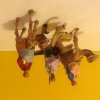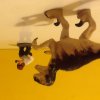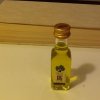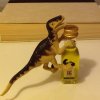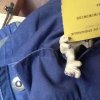Hola!
It's such a happy way to greet someone, 'hola'. And I love being able to say 'adios' for goodbye. I think I've got this European language thing sorted. In Italy, adding vowels to the end of every second or third word did the trick. Our first lesson in Spanish came from our cab driver on the way from the airport to our apartment. He pronounced it 'apartament'. So random vowels inserted in the middle of occasional words might be the go here. And of course the letter 'c' is pronounced as 'th', unless it starts a word. I'll see how all that works.
My first attempt at local communication didn't go swimmingly, I have to admit. I had to go out and buy some dish washing liquid and some soap. Around the corner from where we are staying was a little convenience store run, as they are the world over, by an Indian bloke. I looked on the shelves, but couldn't find the dish washing stuff, so I had to mime the act of washing dishes for him. I reckon I did a pretty good job and I suspect he made me draw it out and do a few times because he was enjoying my performance. Miming soap was easy, I just had to pretend I was in the shower. Another customer joined in on helping solve that one. It occurred to me as I was wrapping up the performance that I was a lot more entertaining than that Charlie Chaplin busker in Venice - and I left the slumped Mexican in Rome for dead. The store owner then made me say three times the Spanish for dish washing stuff and soap. He corrected my pronunciation each time and was very encouraging. Of course, he might have been teaching me to say 'I am a knobhead' and I wouldn't know.
Our apartment is fantastic. It's on the third floor of a four storey apartment building that would be well over 100 years old. It comes with the expected idiosyncrasies of a 100 year old building. We're lucky it has four bedrooms, because the ceiling in the smaller bedroom is coming down bit by bit from a water leak above. I've emailed the owner and suggested she might want to have a look at it. It has an entrance foyer, high ceilings, tiled floors (some of which have a distinct slope), the whole 19th century shebang.
The place is also huge - at least 250 square meters (plus a terrace). But the elevator is tiny. Just as well Spanish people are pretty compact. A hundred years ago, they must have been even more compact. I reckon the elevator is about 900mm x 800mm with manual doors that open inward. There is enough space for two compact people - or one with shopping. The owner of this place brought up three children here and then they moved out of town. There would have been no way to get a stroller into that lift, so she would have done those stairs a few times with heavy loads. What a fantastic place to live, though.
The apartment next door is having renovations done. It's comforting to be all this way from home and hear the sound of power tools. I can identify them by the sound they make. This morning, they had the circular saw, jigsaw and electric plane going, so they're doing some joinery work. I'd like to see what what they're up to. It's a long walk up the stairs for those tradies with their tools and timber.
We're in a district called Gracia. It's an old part of town full of old grand apartment buildings, and around the corner is a food market like I have never seen before. We've got a couple of decent local delis back at home, but this market has at least 20 stalls all better than any of them. And there are also fruit stalls, butchers, half a dozen fish sellers and two blokes selling eggs. Just eggs. Chicken eggs. Nothing exotic. How boring would it be, in the midst of all that fabulous stuff, to be the bloke selling just eggs. I've been to the market most mornings so far to get things for breakfast. I have a coffee at the stall that fuels the market workers, then I buy bread, croissants, and this morning, pickled sardines on crusty bread to bring home. The girls weren't all that keen on the sardines. My dad would have loved the food here. He would have just stayed at the market.
We've ticked off a bunch of the usual tourist stuff in Barcelona - we manage to tick off about three per day. First was that crazy apartment building that Gaudi built - La Pedrera. It's amazing, given he built it over 100 years ago, that there have been so many dreary buildings built since then - the fault of cowardly clients, more than lousy architects. We did the 'hop-on, hop-off' bus tour, which was great - always good to do in a city you're unfamiliar with. Saw en route some more protesters on a street corner, but they seemed more good humoured than the ones in Venice. They looked like uni students. A few were blowing whistles and one of them had a tambourine that she was shaking. Two were hitting saucepans with big spoons - they would have got into strife from their mums that night.
One of the things we did today was the Christmas Market that we had read about. It was rubbish. I suspect the traditional markets in most big cities these days are probably a bit of a disappointment. This one should be renamed the 'nativity scene markets'. Nativity scenes are a big thing over here. You know, the little model of the manger scene with Mary and Joseph and assorted hangers on. Nine out of ten stalls in the market were devoted to nativity scenes. Some sold entire tableaux ready to take home and bung on a sideboard. Others sold just the stable structure and then you could buy the figures and props and make your own display - a bit like making something for a model railway. That gives people a bit of latitude to bulk out their scene with extra characters or leave some out if they're economising or if they have a disliking for one of the wisemen or something. Mimi was keen on getting a nativity scene, so Lisa bargained a guy down to ten euros on a small one because Joseph's staff was busted - a tooth pick should do the trick there.
But one thing I have never heard about was that in this part of Spain - Cataluna - there is another figure they add to their nativity scenes: a Catalan man, with his pants around his ankles, doing a ****. No, really, it's so odd. He's called Caganer. He's been in nativity scenes here for over 200 years - that's way before South Park. I know exactly how it would have started. There would have been two blokes (it's always blokes, with poo jokes) and they would have been sitting around like Garry and I used to when we worked together in advertising agencies. The Garry bloke would have said, 'Hey, you know that nativity scene brief we've got?' I would have looked up hopefully from the the newspaper. He would have gone on, 'Let's put a bloke in the corner doing a **** and see if anybody notices.' I would have put down the paper and said, 'Brilliant. Can we go to lunch now?' And that's how it would have happened. It would have been a joke. The blokes who came up with it would have been a bit disappointed that people weren't offended and embraced it. And now, over 200 years later, it's still going. That poo joke has lasted since before white people lobbed in Australia, and it's still going strong. Every stall in the lame Christmas markets had rows of figures you could choose from for your nativity scene. There were Marys and Josephs and any number of wise men. The were donkeys and other animals. And there were blokes with their pants around their ankles doing a ****.
There were a couple of stalls where they had dispensed with the religious stuff altogether and just had row upon row of blokes doing a ****. And they had strayed a long way from the traditional figure. There was Bob Marley, Darth Vader, The Beatles (all except for Ringo, strangely), Prince William and Kate, all of the Simpsons, Sponge Bob Square Pants (he does yellow poos), Santa Claus, political figures, sporting figures. I was transfixed. Elvis was there, sort of fitting given I think he died on the toilet. There was an Obama figure straining away and printed on the stand around his figure was: 'Yes we can'. It should have said, 'Yes I can.' There was even a Pope (unidentifiable) and a nun. But no Jesus. I definitely would have bought a pooing Jesus. But I bought a pooing anonymous Catalonian man anyway. I had to. You were hoping I did. I carefully selected one that was not an identifiable figure - I wanted to go traditional. With most of them, for stability, the poo reaches from the ground to their bum - like a tripod. I've attached a couple of photos for you. There are also peeing men - little figures with their hands clasped in front of them, hips thrust forward, and a piece of thick fishing line simulating a stream of ****. Imagine what the blokes in those factories in china must think when they churn out that stuff for the civilised world.
But there's more. The people here also have a thing called Caga Tio. That literally means 'poo log'. It's a small log with a smiley face on one end and a traditional hat on top. They cover its back with a blanket to keep it warm and happy. And every night from December 8 kids give the log turron - a Spanish nougat. I suppose they just put it in front of the log and then their parents eat it. Then on Christmas Eve, kids sit astride the log and whack it with a stick singing a ditty than translates as:
Caga Tio hazelnuts and Turron.
If you don't want to poo,
We will hit you with a stick.
And from the rear of the log comes sweets and small toys. I'm a bit lost for words.
But maybe, just maybe, right now as I write this there is a Spanish bloke in Sydney writing that in Australia, on Christmas Eve, people leave out carrots for Santa's reindeer.
It's such a happy way to greet someone, 'hola'. And I love being able to say 'adios' for goodbye. I think I've got this European language thing sorted. In Italy, adding vowels to the end of every second or third word did the trick. Our first lesson in Spanish came from our cab driver on the way from the airport to our apartment. He pronounced it 'apartament'. So random vowels inserted in the middle of occasional words might be the go here. And of course the letter 'c' is pronounced as 'th', unless it starts a word. I'll see how all that works.
My first attempt at local communication didn't go swimmingly, I have to admit. I had to go out and buy some dish washing liquid and some soap. Around the corner from where we are staying was a little convenience store run, as they are the world over, by an Indian bloke. I looked on the shelves, but couldn't find the dish washing stuff, so I had to mime the act of washing dishes for him. I reckon I did a pretty good job and I suspect he made me draw it out and do a few times because he was enjoying my performance. Miming soap was easy, I just had to pretend I was in the shower. Another customer joined in on helping solve that one. It occurred to me as I was wrapping up the performance that I was a lot more entertaining than that Charlie Chaplin busker in Venice - and I left the slumped Mexican in Rome for dead. The store owner then made me say three times the Spanish for dish washing stuff and soap. He corrected my pronunciation each time and was very encouraging. Of course, he might have been teaching me to say 'I am a knobhead' and I wouldn't know.
Our apartment is fantastic. It's on the third floor of a four storey apartment building that would be well over 100 years old. It comes with the expected idiosyncrasies of a 100 year old building. We're lucky it has four bedrooms, because the ceiling in the smaller bedroom is coming down bit by bit from a water leak above. I've emailed the owner and suggested she might want to have a look at it. It has an entrance foyer, high ceilings, tiled floors (some of which have a distinct slope), the whole 19th century shebang.
The place is also huge - at least 250 square meters (plus a terrace). But the elevator is tiny. Just as well Spanish people are pretty compact. A hundred years ago, they must have been even more compact. I reckon the elevator is about 900mm x 800mm with manual doors that open inward. There is enough space for two compact people - or one with shopping. The owner of this place brought up three children here and then they moved out of town. There would have been no way to get a stroller into that lift, so she would have done those stairs a few times with heavy loads. What a fantastic place to live, though.
The apartment next door is having renovations done. It's comforting to be all this way from home and hear the sound of power tools. I can identify them by the sound they make. This morning, they had the circular saw, jigsaw and electric plane going, so they're doing some joinery work. I'd like to see what what they're up to. It's a long walk up the stairs for those tradies with their tools and timber.
We're in a district called Gracia. It's an old part of town full of old grand apartment buildings, and around the corner is a food market like I have never seen before. We've got a couple of decent local delis back at home, but this market has at least 20 stalls all better than any of them. And there are also fruit stalls, butchers, half a dozen fish sellers and two blokes selling eggs. Just eggs. Chicken eggs. Nothing exotic. How boring would it be, in the midst of all that fabulous stuff, to be the bloke selling just eggs. I've been to the market most mornings so far to get things for breakfast. I have a coffee at the stall that fuels the market workers, then I buy bread, croissants, and this morning, pickled sardines on crusty bread to bring home. The girls weren't all that keen on the sardines. My dad would have loved the food here. He would have just stayed at the market.
We've ticked off a bunch of the usual tourist stuff in Barcelona - we manage to tick off about three per day. First was that crazy apartment building that Gaudi built - La Pedrera. It's amazing, given he built it over 100 years ago, that there have been so many dreary buildings built since then - the fault of cowardly clients, more than lousy architects. We did the 'hop-on, hop-off' bus tour, which was great - always good to do in a city you're unfamiliar with. Saw en route some more protesters on a street corner, but they seemed more good humoured than the ones in Venice. They looked like uni students. A few were blowing whistles and one of them had a tambourine that she was shaking. Two were hitting saucepans with big spoons - they would have got into strife from their mums that night.
One of the things we did today was the Christmas Market that we had read about. It was rubbish. I suspect the traditional markets in most big cities these days are probably a bit of a disappointment. This one should be renamed the 'nativity scene markets'. Nativity scenes are a big thing over here. You know, the little model of the manger scene with Mary and Joseph and assorted hangers on. Nine out of ten stalls in the market were devoted to nativity scenes. Some sold entire tableaux ready to take home and bung on a sideboard. Others sold just the stable structure and then you could buy the figures and props and make your own display - a bit like making something for a model railway. That gives people a bit of latitude to bulk out their scene with extra characters or leave some out if they're economising or if they have a disliking for one of the wisemen or something. Mimi was keen on getting a nativity scene, so Lisa bargained a guy down to ten euros on a small one because Joseph's staff was busted - a tooth pick should do the trick there.
But one thing I have never heard about was that in this part of Spain - Cataluna - there is another figure they add to their nativity scenes: a Catalan man, with his pants around his ankles, doing a ****. No, really, it's so odd. He's called Caganer. He's been in nativity scenes here for over 200 years - that's way before South Park. I know exactly how it would have started. There would have been two blokes (it's always blokes, with poo jokes) and they would have been sitting around like Garry and I used to when we worked together in advertising agencies. The Garry bloke would have said, 'Hey, you know that nativity scene brief we've got?' I would have looked up hopefully from the the newspaper. He would have gone on, 'Let's put a bloke in the corner doing a **** and see if anybody notices.' I would have put down the paper and said, 'Brilliant. Can we go to lunch now?' And that's how it would have happened. It would have been a joke. The blokes who came up with it would have been a bit disappointed that people weren't offended and embraced it. And now, over 200 years later, it's still going. That poo joke has lasted since before white people lobbed in Australia, and it's still going strong. Every stall in the lame Christmas markets had rows of figures you could choose from for your nativity scene. There were Marys and Josephs and any number of wise men. The were donkeys and other animals. And there were blokes with their pants around their ankles doing a ****.
There were a couple of stalls where they had dispensed with the religious stuff altogether and just had row upon row of blokes doing a ****. And they had strayed a long way from the traditional figure. There was Bob Marley, Darth Vader, The Beatles (all except for Ringo, strangely), Prince William and Kate, all of the Simpsons, Sponge Bob Square Pants (he does yellow poos), Santa Claus, political figures, sporting figures. I was transfixed. Elvis was there, sort of fitting given I think he died on the toilet. There was an Obama figure straining away and printed on the stand around his figure was: 'Yes we can'. It should have said, 'Yes I can.' There was even a Pope (unidentifiable) and a nun. But no Jesus. I definitely would have bought a pooing Jesus. But I bought a pooing anonymous Catalonian man anyway. I had to. You were hoping I did. I carefully selected one that was not an identifiable figure - I wanted to go traditional. With most of them, for stability, the poo reaches from the ground to their bum - like a tripod. I've attached a couple of photos for you. There are also peeing men - little figures with their hands clasped in front of them, hips thrust forward, and a piece of thick fishing line simulating a stream of ****. Imagine what the blokes in those factories in china must think when they churn out that stuff for the civilised world.
But there's more. The people here also have a thing called Caga Tio. That literally means 'poo log'. It's a small log with a smiley face on one end and a traditional hat on top. They cover its back with a blanket to keep it warm and happy. And every night from December 8 kids give the log turron - a Spanish nougat. I suppose they just put it in front of the log and then their parents eat it. Then on Christmas Eve, kids sit astride the log and whack it with a stick singing a ditty than translates as:
Caga Tio hazelnuts and Turron.
If you don't want to poo,
We will hit you with a stick.
And from the rear of the log comes sweets and small toys. I'm a bit lost for words.
But maybe, just maybe, right now as I write this there is a Spanish bloke in Sydney writing that in Australia, on Christmas Eve, people leave out carrots for Santa's reindeer.




